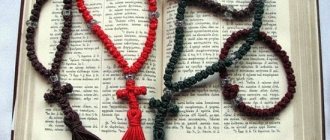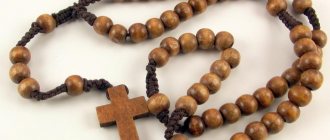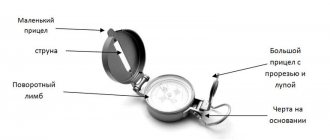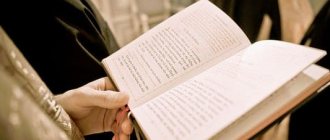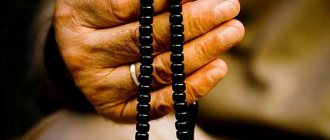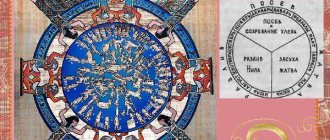What is a rosary?
The word “rosary” is derived from the Old Russian “count”, “read”. Outwardly, they look like this: a cord closed in a ring, on which objects (beads), plates, or knots are tied. They are used in many beliefs: in Hinduism, Islam, Buddhism from the 2nd millennium BC. The oldest rosary was found in India.
They came to Christianity in the 4th century, introduced into practice by Saint Pachomius. Rosaries are of great importance in monasticism; they are given to a monk at the time of tonsure, called the “spiritual sword.” Monks never part with their rosary, which helps them strengthen the connection of their souls with the Lord.
Lestovki
Lestovki are, as already mentioned, the most ancient Orthodox rosary used in the Russian Orthodox tradition. They come from the so-called vervitsa - a rope with knots, common in Byzantium and performing the same role of counting prayers.
The word “lestovka” means “ladder” - it means a staircase to heaven, to God. This is no accident. Orthodox rosaries in the form of a ladder really look like a ladder, since they do not look like beads, but a leather belt, along the entire length of which there are some kind of steps - wide loops called bobbins. The arrangement of the latter is based on a rather complex system. The ends of the ladders are sewn together in a special way with triangles called paws. And inside the beans there is a thick paper roller. According to the rules, the words of prayers were written on these pieces of paper, but now this tradition is rarely maintained.
This type of rosary is also divided into several types. Thus, there are male, female and children's ladders. There are also everyday, funeral, wedding and holiday options.
As already mentioned, lestovki are Orthodox rosary beads that have lost their meaning today. Their photo is located below.
Why do Christians need rosary beads?
The purpose of the rosary is approximately the same in all religions of the world. Something like this:
- Repeated prayer is a symbol of faith, a person’s appeal to God, to the saints and angels, expressed in petition, thanksgiving and praise. Often prayer is accompanied by bows or other ritual actions. Thanks to the simplest counting device, such as a rosary, a believer can, by sorting the beads, keep count of the prayers or actions performed.
- Turning to the Lord requires maximum concentration and concentration from the believer. Rosary beads help you to gather yourself and not be distracted from prayer.
- The rosary, stored in an easily accessible place, on the wrist, belt, in a case, in front of the eyes, is a reminder of prayer. A cord connected into a ring symbolizes continuous prayer, serving to cleanse the soul.
- Using a rosary allows you to maintain a certain rhythm by fingering the beads. In some ritual actions this is important.
- Rosaries in religion are endowed with symbolic meanings. In Orthodoxy, the rosary is a ladder from earth to heaven; beads are stones on which sinful thoughts are broken; the circle of rosaries are fortress walls protecting a person. The rosary is a spiritual path that never ends.
- Each denomination's rosary has its own distinctive features, allowing one to draw conclusions about the affiliation of their owner to any religion or the degree of his preparation. There are such features in Orthodoxy. Currently, only monks should use rosaries as a mandatory attribute. The laity, who were previously required to pray with a rosary in their hands, today are free from this, and rarely use this accessory.
Beware of hypocrisy and delusion
I would like to warn our laity against Pharisaism, because it is very easy to turn into a person who “increases the opening of the vestments,” as the Savior says, denouncing Pharisaic vanity and pride. “But you, when you pray, go into your room and, having shut your door, pray to your Father who is in secret; and your Father, who sees in secret, will reward you openly” (Matthew 8:8). Read the Jesus Prayer, use the rosary, but don’t show it to others. There is a tradition of falling asleep with a rosary, when a person reads the Jesus Prayer before going to bed - this is very good. There is no need to take long rosaries, take the smallest ones, on your finger, and read.
I would really like to encourage believers who use rosaries: there is no need to count prayers or do arithmetic. “I read 150 yesterday, today I’ll read 250!” - this is not a sport. When this starts, you are very afraid for the person. It's not about arithmetic. St. Ignatius Brianchaninov, St. Barsanuphius of Optina and other holy fathers write very competently about this. They teach: you don’t need to engage in prayer, you need to pray to it. This is a living appeal to the living God. But one must be very careful with spiritual exploits.
Saint Ignatius has the following example: an ascetic came to him who did not experience hunger, and in winter he walked in one cassock and did not sleep for days. The saint asked: “How do you, dear one, pray?” He told, and the saint asked him to pray, as the holy fathers teach. A week later, the ascetic came in upset feelings with the question: “What have you done to me?!” He developed a huge appetite, he began to feel cold, and could not wake up in the morning. That is, the demon of vanity helped him, and when that monk began not to engage in prayer, but to pray, the demon moved away from the words of the Jesus Prayer, as if from fire, and everything changed. We need to tell the laity about this and warn them.
Let me emphasize: all of the above does not apply to monks. They have their own life, they obey the established rules, fulfill the blessing of the abbot and live according to obedience. In the world, you need to be very careful with your spiritual load.
Types of Orthodox rosary
In Orthodoxy, several versions of the rosary were used. Over time, new ones were added to them, and some became outdated and became a thing of the past. Orthodox rosaries can be distinguished by their appearance from rosaries of other faiths. For example, the “rosary” rosary used in Catholicism has a different number of grains and their division into groups.
Orthodox rosary “lestovka” is one of the earliest options, used in pre-schism Rus'. Later they were forced out of use by other types, but remained in use by the Old Believers. Lestovka, which means stairs, is a rosary and resembles it in its appearance. It has steps along its length, that is, loops called bobbins. They are located and separated in a certain system. Rolls of paper with different prayers are placed inside the beans. The edges of the ladders are connected and sewn up with triangles, paws or petals. Creed - prayer in different services can have different purposes. That’s why they made different types of landings: festive, everyday, wedding, funeral, and so on. Nowadays, authentic lestovki can be seen extremely rarely: in photographs, from Old Believers or in museums. In Orthodoxy, they were once replaced by ropes.
Vervitsa is a traditional type of knotted rosary. It got its name from the word “rope”, since at first it was not locked into a ring, but looked like a belt with knots tied on it. The knitted rope ends at the junction of the edges with a brush or a cross. This type is most often seen among Orthodox monks or parishioners. The very name “vervitsa” has almost gone out of use, replaced by the general concept of “rosary”.
Is this for monks or lay people?
The rosary is a purely monastic attribute, like a military uniform: jacket, shoulder straps, and so on. This is what monks have: hood, mantle, rosary, cross, paraman. Monasticism arose in the 4th-5th centuries after the Nativity of Christ as a result of the cessation of persecution of the Church from without and its emergence within - sects, schisms, disorder, and so on. People had a thirst for seeking an ascetic life for the sake of the Lord. Therefore, the rosary is such a spiritual sword, a reminder that monks are prayer books for the whole world. This is an integral part of even the appearance of monastics, an object that has not only practical, but also a certain symbolic meaning.
As for the laity, probably every experienced priest has encountered the problem when new believers strive to conform to some monastic stereotypes. Especially men: they have a desire to grow a beard and long hair, take a blessing on their rosary, and use them demonstratively during church services. We must immediately warn you that in this case there is a high probability of error and the wrong path. The manifestation of one’s aspirations and spiritual exercises is alarming. A person, without realizing it, can fall into delusion, a false self-image, conceit, pride, vanity, and so on.
How many beads can there be in a rosary?
In classic Orthodox rosaries, the number of beads can be selected based on two principles. In the first case, there are 33 of them, which indicates the amount of Christ’s earthly age. The most popular are ropes with a number of beads that are multiples of ten. In a monastic “spiritual sword,” the number of beads is most often 100, but can reach up to a thousand.
Each ten beads are separated from each other by a separator different from the main set. This could be a bead of a different size, or shape, or another object that will stand out from the crowd to the touch.
Broyanitsa
This is the Serbian version of the Orthodox rosary. It is a simplified and more compact version of the rope and is similar to home sewing. Broyanitsa is worn on the hand in the form of a bracelet. It is made mainly from leather, woolen threads, and thick fabric. The required number of knots is 33. This number is associated with the number of years lived by Jesus Christ on Earth.
The peculiarity of the rosary is that the cord is connected by an equilateral metal or wooden cross. Very often this cross is made of precious material and a small icon is engraved on it. Folk traditions say that you cannot buy broyanitsa or make it yourself. It should be given away.
How to use rosaries in Orthodoxy?
You can read any prayer using the rosary. The reading of the prayer is accompanied by the counting of one bead after its completion.
For example, it is recommended to conduct a daily appeal to the Lord as follows: the main prayer is read ten times, after each time, one bead is pressed between the thumb and forefinger on the rosary with the fingers. After the tenth time, the line reaches the separator, which means it’s time to read the prayer to the Mother of God.
When praying, do not forget to sign yourself with the sign of the cross; rosary beads can also help with this. At the end of the thread, “Our Father” is read. You can combine the reading of prayers based on each specific case.
What else can rosary be used for and how to use them?
During the offering of prayer, the rosary not only serves to count prayers, but also helps to tune in and relax. Quiet concentration on prayer clears the mind of worldly worries and worries. When the fingertips touch the smooth beads, the believer is immersed in a peaceful state. By fingering the rosary, they learn to get rid of bad thoughts and anger, and accustom themselves to patience.
Many people who see or pick up a rosary for the first time wonder about their purpose. Initially, they were used during ritual actions - counting prayers or bows. After reading one prayer or making a bow, they moved one bead, thereby counting the action performed. That's why the rosary began to be called that.
For Orthodox rosaries, the number of beads is strictly defined. Each bead can have its own size. This way it will be more convenient to understand the required number of readings for each prayer included in the cycle.
In order to count prayers, the beads are fingered with the fingers of the left hand simultaneously with the offering of a new prayer. A single bead corresponds to one prayer. When, sorting through the small beads, they reach a large one, they stop and say the prayer “Rejoice to the Virgin Mary” or “It is worthy to eat”, then the Jesus Prayer. After the required number of prayers have been read, they finish praying and read the “Our Father.” Various prayers are read using the rosary.
Over time, rosaries began to be used for other purposes.
- Beads were used by wandering ascetics for a relaxing massage that helped relieve fatigue.
- Fingering the rosary calms and relieves stress.
- We cannot ignore the benefits of tactile touching the rosary. Massaging the fingertips, where the nerve endings are located, has a positive effect on the health of internal organs.
In esotericism, beads are used to correct and fix certain programs. This seemingly purely ecclesiastical instrument for prayer can serve as a talisman designed to cleanse the aura and attract positive energy.
For more information on how to use the rosary, see here:
How long should prayer last?
The next question: “How long to pray with the rosary in Orthodoxy, how to make sure that the prayer is sufficient?” Everyone determines the duration of prayer for themselves. There are no instructions for the laity on this matter. The main thing in turning to God is sincerity, and over time you can determine it experimentally.
Conduct morning and evening prayers according to the needs of your soul, noticing for yourself how much time it took by the clock and how many times you walked around the circle of the rosary. Comparison of these initial data will determine the further duration of your prayer.
What is the difference between purchased and self-made rosaries?
A rosary bought in a church shop is a consecrated object, made in accordance with all the rules that apply to Orthodox rosaries. As a result, needlewomen will have a product for secular purposes (before it is consecrated in the temple). On the other hand, a thing made according to your taste, vision, comfortable for your fingers, is more pleasant to hold in your hands.
As grains (beads), you can use knots on a rope and other objects that are pleasant to you. Most often round in shape, the balls are made of a variety of materials. In ancient times, even dried berries were the first grains.
Gotta be realistic
The task of a praying person, according to the holy fathers, is to “restrain the uncontrollable,” that is, our mind. Don’t let yourself get distracted, focus on prayer. The saints distinguished several stages of prayer: attentive prayer, mental work, heartfelt prayer, unceasing work - hesychasts constantly did this, but these are great things of a purely monastic level. A worldly person must be aware and not engage in fantasies about himself - that while living in the world, he can reach the level of a hermit who spent fifty years of monastic life on this. We must be realistic: look at these things calmly and use what we can handle. Set realistic goals and strive for them.
In conclusion, I would like to remind you: if a person prays only when he reads the rule, he is not praying at all. A believer should always have the memory of the Lord. Both in work and in all matters, one must turn to God, thank Him, ask for blessings - that is, live according to the covenant of the Apostle Paul: “Rejoice always. Pray without ceasing. In everything give thanks: for this is the will of God in Christ Jesus for you” (1 Thess. 5:16-18). The Jesus Prayer is for everyone, not just monks. This is the abridged Gospel, its quintessence. There is an idea that the five words of the Jesus Prayer are similar to the five stones of David in the battle with Goliath, which he collected from the stream when he went to battle - with firm confidence that God would give him victory over the enemy in an unequal battle.
There is no need for external paraphernalia, no need to count prayers. It’s better, as St. Theophan the Recluse writes, if you have time, set an alarm clock and pray for ten to fifteen minutes. I would recommend that laity use rosaries only for private, home prayer. After all, prayer and rosary beads are very secret, intimate things that are not made public.
Archpriest Konstantin Lisnyak
Making your own rosary
- You need to decide on the size of your rosary. The smallest ones, which are worn on the finger, have ten beads. Thirty-three is the age of Christ. Fifty knots or beads symbolize Pentecost. Seventy grains are a reminder of the seventy apostles. Rosaries with one hundred beads are used by monks.
- Prepare the required number of beads of the same size. For every nine pieces you need one separator - a bead of a larger or smaller size. A cord is also required.
- The rosary is assembled in a simple sequence: each bead is secured on both sides with knots, and the assembled thread is connected into a ring and secured with a brush or cross.
Structure of ladders
The structure of the ladders is quite difficult to remember right off the bat. This is aggravated by the fact that there are several types of them. The classic version is a circle of one hundred and nine beans. It starts with four paws sewn into a herringbone pattern. They symbolize the Trinity, and their number is the number of evangelists. Further along the ladder ribbon there are three bobbins, and after them there is an empty area. Following this are twelve more small steps, followed by one large one. Next - another thirty-eight small beans and again one large one. They are followed by another cycle of thirty-three stages of small elements plus one large one. Then there are seventeen small beans, again an empty area and finally three more beans.
Choosing a rosary
Having understood how to use rosaries in Orthodoxy, all that remains is to choose the kind of rosary that will be convenient and pleasant to hold in your hand for a long time. This is a very personal item and should only evoke positive emotions. You need to hold the vervitsa in your hands, sorting through the grains, and listen to your feelings.
It is most pleasant to hold a wooden product in your hands, which is why Orthodox rosaries are most often made from this material. The rosary quickly gains the energy of its owner, so only new products are suitable as a gift. An exception is the gift of a mentor to his student.
Self-production
There is nothing difficult about stringing a series of beads on a thread. This process cannot be fully called the making of rosaries, since this concept implies their knitting. This is a monastic activity during which work on prayer continues. But the laity, if they wish and with the blessing of their confessor, can begin this activity.
Knitting Orthodox rosaries is not easy. Each node is performed in a strictly defined sequence of actions. The most convenient material for their manufacture, especially if a person does not have the skills and dexterity, is soutache. It is better to comprehend this process with the help of an experienced person, or using visual video instructions.
It is important to remember that the process of knitting rosaries is not a type of needlework, but a way and opportunity to perform the Jesus Prayer.
The process of making Christian rosaries
